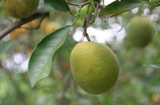Managing Citrus Greening
Written January 2011; edited December 2011.
Huanglongbing (also known as HLB or citrus greening) is a disease affecting citrus production all over the globe. In Florida, the disease is spreading through all citrus-producing counties, carried by the Asian citrus psyllid. These psyllids transmit the bacteria Candidatus Liberibacter asiaticus, which is thought to cause the disease.
Trees infected with HLB may display the following:
- Leaf vein yellowing, yellow shoots, or “blotchy mottle” (asymmetrical leaf chlorosis, which can resemble mineral deficiencies).
- Poor fruit production and lopsided, small fruits that ripen improperly and drop early.
As the disease progresses, it spreads from the infected shoot or branch to the entire tree. Root systems develop poorly, and dieback and productivity decline usually occur within a few years.
HLB affects all citrus, regardless of root stock. The symptoms are severe in sweet orange and mandarins (and hybrids), but moderate in grapefruit, lemon, and sour orange. The bacterium still infects and multiplies in cultivars considered “tolerant,” so even if their symptoms are less severe, these trees remain sources for infection of others.
HLB is difficult to manage and can continue to spread through Florida citrus since the Asian citrus psyllid is well established. Recommended management guidelines are listed below.
- HLB can spread with infected budwood. Use only clean budwood and certified healthy trees. It is mandatory for nursery production in Florida to be in psyllid-proof enclosures and that nursery and budwood sources are certified HLB-free.
- The Asian citrus psyllid feeds on other plants in the same family as citrus. Both orange jasmine (Murraya paniculata) and orange boxwood (Severinia buxifolia) have been found to serve as hosts for both psyllids and the bacterium. These ornamentals are restricted under state compliance agreements and should not be moved from diseased areas.
- Routinely scout citrus for signs of greening so that infected trees can be removed. Scouting should be done at least four times a year, or more in areas known to have HLB-infected trees. October through March is the best time for scouting, but symptoms can be present at other times of the year.
- First diagnose suspected trees with an iodine-based starch test, and then send for a polymerase chain reaction analysis (PCR) diagnosis. The iodine test identifies if the tree is likely to have HLB—this is not a positive diagnosis (See: An Iodine-Based Starch Test to Assist in Selecting Leaves for HLB Testing). A sample of possible infected trees should then be sent for PCR diagnosis to the Southern Gardens Diagnostic Laboratory or the Southwest Florida Research and Education Center in Immokalee. Submission forms and information are available at the Citrus Research and Education Center (CREC) Extension.
- Remove infected trees. This is the only way to ensure that they won’t remain a source of infection for other trees. Pruning symptomatic limbs is often ineffective since other parts of the tree may be infected, but do not show symptoms. Before removing, the tree should be sprayed with a foliar insecticide to kill any psyllids in order to keep them from moving on once the tree is removed.
- Focus your Integrated Pest Management (IPM) efforts on using disease-free nursery trees, reducing infection sources (inoculum) by frequent surveys and diseased tree removal, and suppressing Asian citrus psyllid through area-wide management.
HLB will most likely never be eradicated, but following these management guidelines will work to help keep infection rates low. A coordinated, area-wide management strategy of psyllid control, scouting, and rapid removal of infected trees should ensure continued viability and productivity of Florida’s citrus industry.
For more information, read the source document, 2011 Florida Citrus Pest Management Guide: Huanglongbing (Citrus Greening) or visit your local Extension office.
Adapted and excerpted from:
R. Brlansky, et al, 2011 Florida Citrus Pest Management Guide: Huanglongbing (Citrus Greening) (PP-225), Plant Pathology Department (rev. 11/2010).

Related Sites & Articles
- UF/IFAS Publications
- Iodine-Based Starch Test for Selecting for Citrus Greening
- Sampling for Asian Citrus Psyllid in Florida Citrus Groves
- Scouting for Citrus Greening
- UF/IFAS Sites
- Citrus Greening Database
- Citrus Greening

